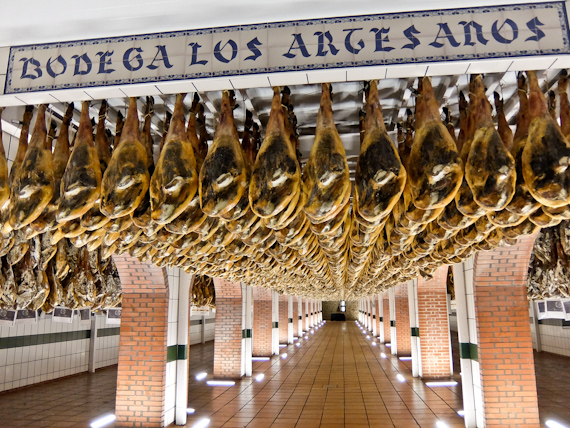Rupert Parker discovers Ibérica ham and sherry in Andalucia while hiking around Picos de Aroche Natural Park.
The Sierra de Aracena and Picos de Aroche Natural Park is a relatively unknown part of Andalucía, around an hour’s drive west from Seville
This is a landscape of gently rolling hills, 90% forested by mainly Mediterranean oak, with dramatic rocky outcrops rearing out of the trees. Whitewashed towns and villages, often huddled around a large church or castle, are linked by an extensive network of footpaths and centuries-old drovers’ tracks.
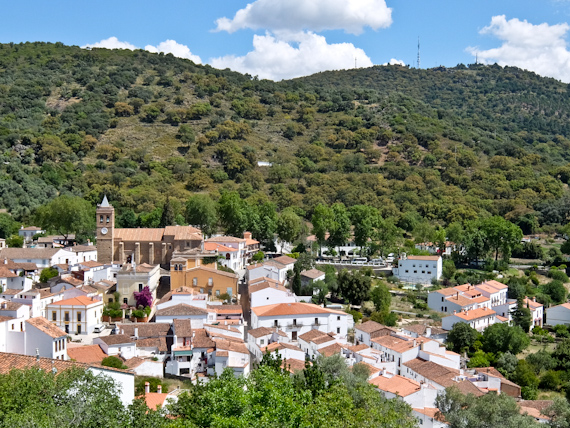
Aracena, with its own medieval church and ruined castle, makes a good base to explore the region but you won’t be alone. Everywhere I walk I see groups of black pigs, chomping away on acorns lying on the ground. These are Iberico pigs, a unique breed which was imported into Spain by the Phoenicians, thousands of years ago, closely related to the wild boar. Their cured hams, coming from both back and front legs, are known as Jamón Ibérico, the best in Spain and some would say the best in the world.
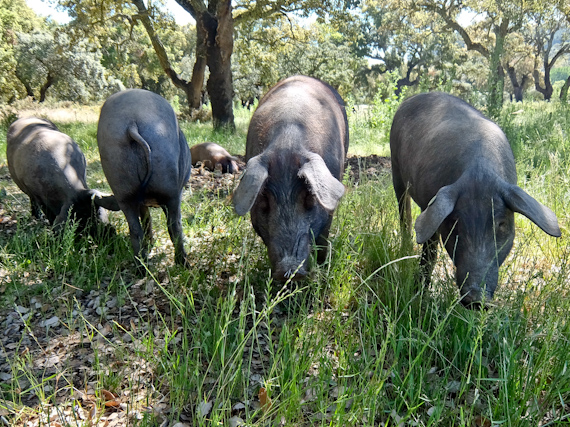
The regulations are strict – each pig must come from purebred parents, have at least two hectares to roam and can only eat acorns and grass. In the months preceding their slaughter they wander over 14km a day, consuming around 7kg of acorns and 3kg of grass, plus wild berries, roots, mushrooms, aromatic plants, small invertebrates and nuts. This amount of exercise needs a large supply of oxygen to the muscles in their legs and this adds a distinctive vein of fat running through their hams. They’re also high in Oleic acid, the same ingredient in Olive Oil, so some call them “Olives on legs”.
I’m hiking from the 16th-century village of Castaño del Robledo, famous for its chestnuts, to Jabugo, a pleasant stroll through the oak forests. My destination is the curing facility for Cinco Jotas and as I approach their huge cellar, 600m long, there’s a definite hammy smell in the air. Inside, I can see why – around 100,000 hams hang on hooks from the ceiling, like bats in a cave, and here they’re hung for over three years. They’re painted with oil every three months to control mould and moved around 20 times.
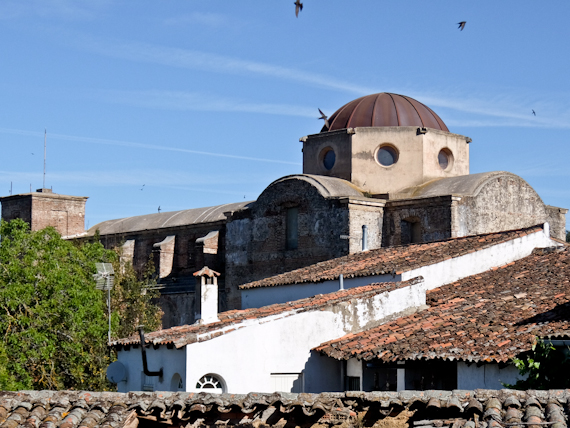
In the tasting room, I get a chance to try some for myself. Different parts yield unique tastes and it’s easy to spot the differences on the plate. The Maza, from the centre and the largest part, has clean striations of fat with the meat soft and juicy; the Punta is from the top of the thigh and is sweeter with more marbling; the Cana comes from near the foot and is slightly chewy, but packed with flavour. If you order Iberico in a restaurant you’re not usually given the choice, but my favourite is the Punta.
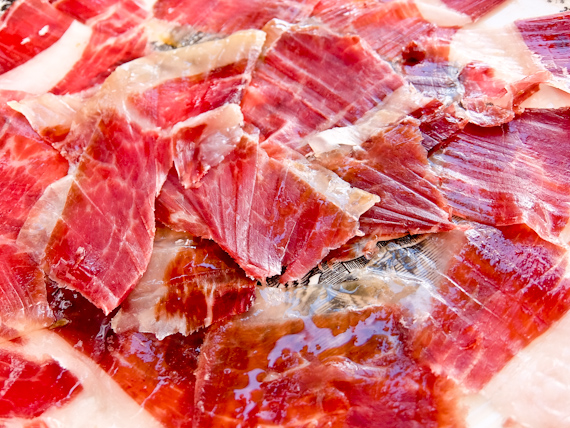
Naturally, a glass of Fino sherry is meant to be the perfect pairing with Jamón Ibérico and across Andalusia, the town of El Puerto de Santa María on the coast near Cadiz, is the home to the “cathedral” of sherry. Bodegas Osborne has been making the stuff here since 1772 when the firm was founded by English entrepreneur Thomas Osborne Mann. England got its taste for sherry when privateers like Francis Drake hijacked Spanish ships and donated some of their booty to the crown.
The present winery dates from 1830 and is piled high with over 600 barrels. Its high ceiling and black walls keep the temperature between 24-25C during the long summers and a constant humidity of 80% is maintained. The barrels are made from American oak and some are over 150 years old, although the majority are around 100 years.
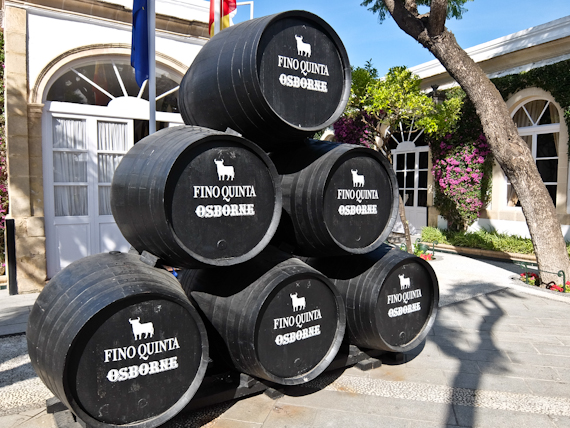
Sherry is a fortified wine made primarily from Palomino grapes, indigenous to the area around Jerez, although some Pedro Ximénez is added for the sweeter versions. After harvest in September, fermentation is allowed to occur in stainless steel until late November. At this stage, it’s a dry white wine, about 12% alcohol but it’s then made up to 15% by adding distilled grape spirit and transferred to 600-litre barrels. They’re filled five-sixths full, with space at the top to allow “flor”, a layer of yeast. to develop on the surface of the wine. Fino is aged for a minimum of three years, up to a maximum of seven.
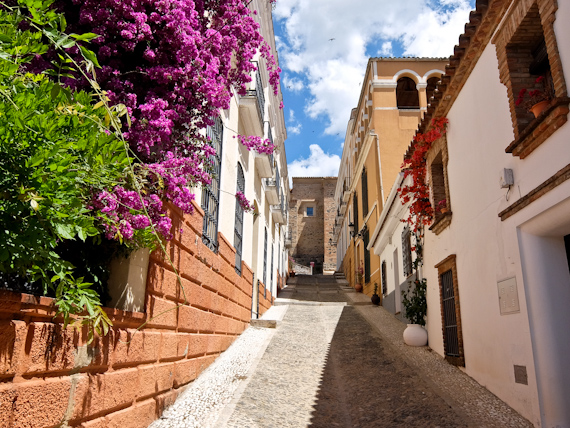
Contrary to English habits of drinking it only at Christmas and returning to the same bottle year after year, sherry should be drunk as soon as it’s opened. Although I have a number of glasses of Fino around town, the guided tasting at Osborne shows me how good it can be. In particular, the V.O.R.S. (Very Old Rare Sherry) is aged in barrels for at least 30 years and my favourite, the Solera BC 200, for 40 years. At €200 a bottle it’s not cheap but compared to malt whisky of the same age, it’s definitely a bargain.
Tell More About Ham And Sherry in Andalucia
A visit to Cinco Jotas in Jabugo costs from £53 pp, including a tour of the curing cellars, meadows and jamón tasting. Cinco Jotas acorn-fed 100% jamón ibérico ranges from £13 for a 40 g pre-sliced pack, to £670 for a 7-8 kg leg of jamón, and is available at the Harrods Food Hall.
A guided tour of the Bodegas Osborne in El Puerto de Santa María costs €12 per person. Tasting of V.O.R.S is extra.
.Hotel Convento de Aracena makes a good base in Aracena, and was once a convent.
Las Bellotas is next door to the cellars in Jabugo and serves Cinco Jotas meats.
Palacio San Bartolomé is a luxurious base in Puerto Santa María.
British Airways flies direct to Seville from London Gatwick.
The Gatwick Express is the fastest way to get to the airport from central London.

